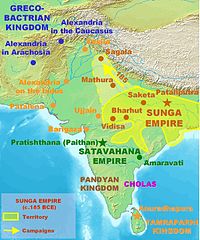

The middle period was a time of notable cultural development. The Satavahanas, also known as the Andhras, was a dynasty which ruled in southern and central India starting from around 230 BC. Satakarni, the sixth ruler of the Satvahana dynasty, defeated the Sunga Empire of North India. Kharavela was the warrior king of Kalinga[30] and was responsible for the propagation of Jainism in the Indian Subcontinent.[31] The Kharavelan Jain empire had a formidable maritime empire with trading routes linking it to Sri Lanka, Burma, Thailand, Vietnam, Cambodia, Borneo, Bali, Sumatra and Java. Colonists from Kalinga settled in Sri Lanka, Burma, as well as the Maldives and Malay Archipelago. Kuninda Kingdom was a small Himalayan state that survived from around the 2nd century BC to roughly the 3rd century CE. The Kushanas migrated into north-western India in the middle of the 1st century CE, from Central Asia, and founded an empire that eventually stretched from Tajikistan to the middle Ganges. The Western Satraps (35-405 CE) were Saka rulers of the western and central part of India. They were the successors of the Indo-Scythians (see below) and contemporaneous with the Kushans who ruled the northern part of the Indian subcontinent, and the Satavahana (Andhra) who ruled in central and southern India.
Different empires such as the Pandyans, Cholas, Cheras, Kadambas, Western Gangas, Pallavas and Chalukyas dominated the southern part of the Indian peninsula, at different periods of time. Several southern kingdoms formed overseas empires that stretched across South East Asia. The kingdoms warred with each other and Deccan states, for domination of the south. Kalabhras, a Buddhist kingdom, briefly interrupted the usual domination of the Cholas, Cheras and Pandyas in the South.

No comments:
Post a Comment